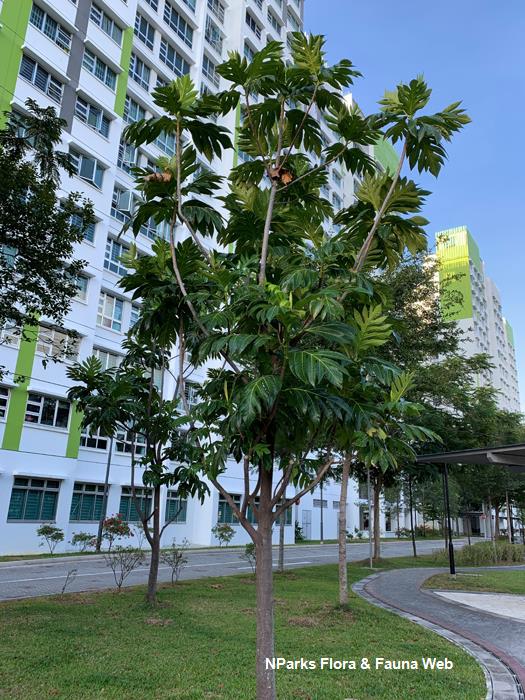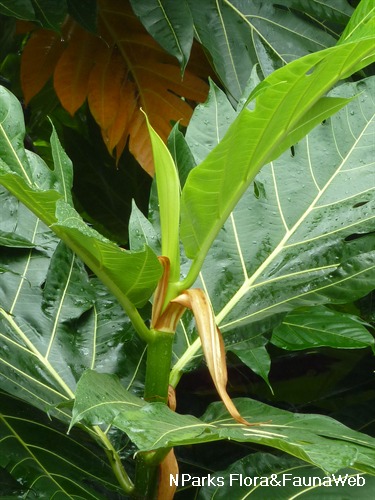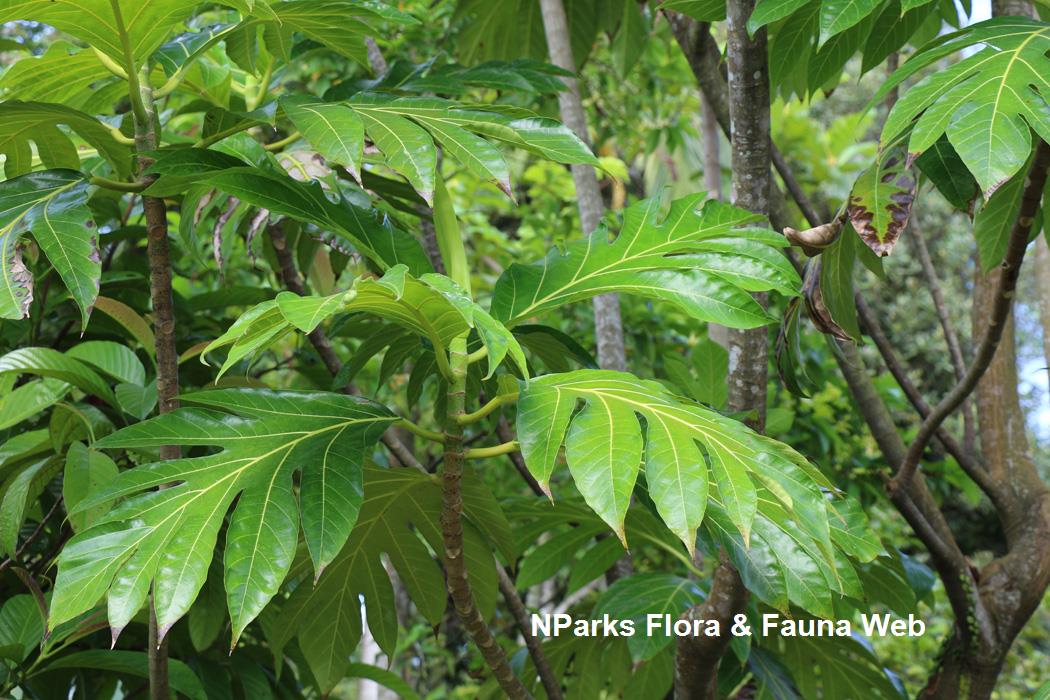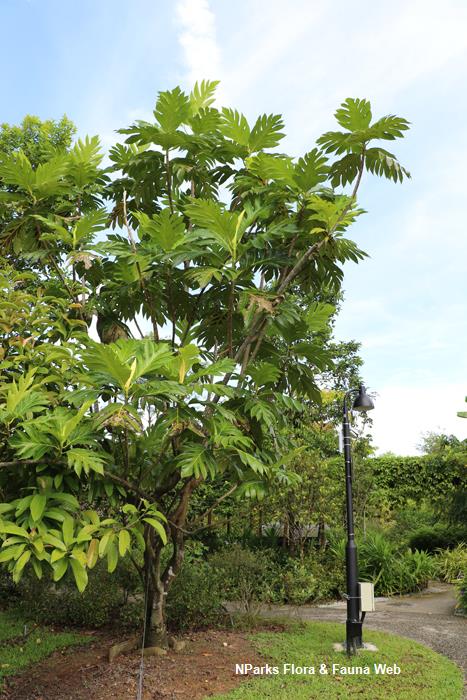_lowres.jpg)
Back
Artocarpus altilis (Parkinson) Fosberg
| Family Name: | Moraceae |
| Synonyms: | Artocarpus communis J.R.Forst. & G.Forst., Artocarpus incisus (Thunb.) L.f., |
| Common Name: | Breadfruit, Sukun, Suku, Kulur, Kelor |
Name
Classifications and Characteristics
| Plant Division | Angiosperms (Flowering Seed Plants) |
|---|---|
| Plant Growth Form | Tree |
| Lifespan (in Singapore) | Perennial |
| Mode of Nutrition | Autotrophic |
| Maximum Height | 40 m |
| Tree or Palm – Trunk Diameter | 0 to 1 |
Biogeography
| Native Distribution | Malaysia to Tahiti |
|---|---|
| Native Habitat | Terrestrial |
| Preferred Climate Zone | Tropical |
| Local Conservation Status | Non-native |
Description and Ethnobotany
| Growth Form | It is a monoecious tree that can grow up to 40 m. |
|---|---|
| Others - Plant Morphology | Artocarpus altilis is an evergreen tree in humid tropics but semi-deciduous in monsoon climate. Its, 5 – 8 m tall, trunk can reach a diameter of 0.6 – 1.8 m. Alternate, ovate to elliptical, leaves. Inflorences axillary, male flower drooping, shaped like a club and the female flower stiffly upright, globose or cylindrical.Propagated from seed, the seed must be planted when fairly fresh as they will lose viability within a few weeks and it cannot be stored in refrigerator. Before planting breadfruit trees in a well-enriched hole, 40 cm deep and 90 cm wide, the hole must be sterilise by burning trash in them and mixed the soil with insecticide to protect roots and shoots from grubs, thick wormlike larva. However, well-drained clay loams under partial shade are the optimum condition for it to grow.Fruits, immature or ripe, and seeds are boiled, baked, roasted or fried before consuming.Before making it into a biscuit, the ripe fruits are cooked before drying it in sun or oven.Fruits can be made into a nutritious cheese-like paste, by letting it ferments, and made into cakes and baked.Blended with the fibre of paper mulberry, the male flower spikes can be used to produce loincloths.When diluted with rain water, the latex, from the trunk, can be used to treat diarrhoea. As the wood is light yet firm and nicely grained, it is used to make canoes, surfboards, toys, boxes and crates. |
| Ethnobotanical Uses | Edible Plant Parts : Edible Fruits, Edible Leaves Food (Fruit or Vegetable) (Herb or Spice) |
Landscaping Features
| Thematic Landscaping | Economic Garden |
|---|
Fauna, Pollination and Dispersal
| Pollination Method(s) | Abiotic (Wind) |
|---|
Plant Care and Propagation
| Light Preference | Full Sun |
|---|---|
| Water Preference | Moderate Water |
| Plant Growth Rate | Moderate |
| Propagation Method | Seed, Root Cutting, Sucker, Air-Layering |
Foliar
| Mature Foliage Colour(s) | Green |
|---|---|
| Mature Foliage Texture(s) | Glossy / Shiny, Leathery, Rough, Thick |
| Foliar Shape(s) | Non-Palm Foliage (Ovate, Lanceolate) |
| Leaf Area Index (LAI) for Green Plot Ratio | 2.5 (Tree - Open Canopy) |
Non - Foliar and Storage
| Root Type | Aboveground (Buttress Root) |
|---|
Floral (Angiosperm)
| Flower & Plant Sexuality | Unisexual Flowers , Monoecious |
| Flower Colour(s) | Green, Yellow / Golden |
|---|
| Inflorescence Size Remarks | Male flowers are yellow while female are green. |
Fruit, Seed and Spore
| Mature Fruit Colour(s) | Green, Yellow / Golden |
|---|
Image Repository
Others
| Master ID | 1438 |
|---|---|
| Species ID | 2731 |
| Flora Disclaimer | The information in this website has been compiled from reliable sources, such as reference works on medicinal plants. It is not a substitute for medical advice or treatment and NParks does not purport to provide any medical advice. Readers should always consult his/her physician before using or consuming a plant for medicinal purposes. |


_lowres.jpg)
_lowres.jpg)












.jpg)
.jpg)



_lowres.jpg)

